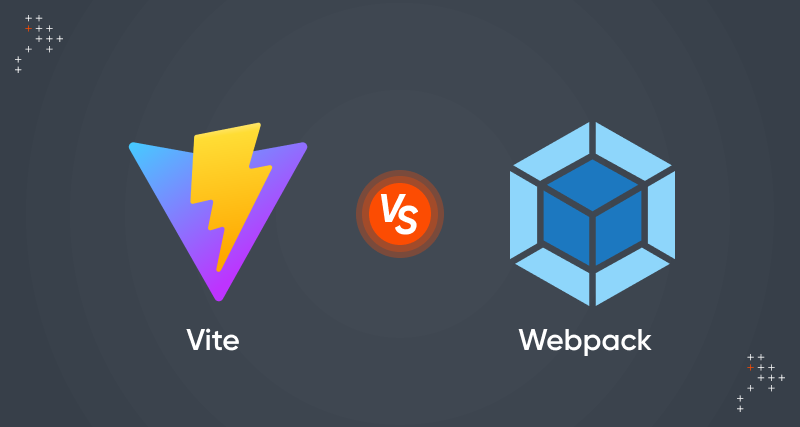Introduction
Webpack and Vite are two of the most popular tools for creating React applications.
Webpack is a powerful and versatile bundler that can handle complex, large-scale projects with ease. With millions of weekly downloads from the NPM repository and robust community support, Webpack is one of the most popular bundlers in the market.
Vite is rapidly gaining traction for its versatility and efficiency in addressing bundling time issues. Built on native ES modules, Vite offers a lightweight, fast, and user-friendly development server, making it an excellent choice for small to medium-sized projects.
Understanding Webpack
Webpack is a free and open-source module bundler for JavaScript. It can also transform frontend assets such as HTML, CSS, and images, if the corresponding loaders are included. Webpack accepts modules with dependencies and generates static assets representing those modules.
The built-in development server of Webpack, “webpack-dev-server” can be used as an HTTP server for serving files while developing. The module replacement (HMR) capability of Webpack updates code on a web page without reloading the page.
Challenges With Using Webpack
In React.js applications, Webpack is used as a module bundler when starting a new project using the create-react-app tool. Compared to Vite, Webpack has several drawbacks.
The following React.js project will show some of the major drawbacks of using Webpack.
Large Number Of Dependencies
While initializing a React app, “npx create-react-app” downloads a large number of package dependencies. In one minute, around 1558 packages were added.
Slow Starts
When the React development server is started for the first time, it takes time compared to Vite.
Slow HMR Updates
While working with a larger React project with many components, changes in the source code take longer to be reflected in the browser. This is because Webpack compiles files in a bundle-based format.
Bundle-Based Dev Server
When cold-starting the Dev Server, a bundler-based build setup has to crawl and build the entire application before it can be served.

Before starting the development server, Webpack will automatically scan through all dependencies and source code.
Understanding Vite
Vite JS is a very popular, lightning-fast, and feature-rich module bundler. Vite supports modern browsers without the need to build them by using native browser ES imports.
Vite uses the browser's native ES modules to speed up compilation, especially during development. Unlike Webpack, Vite’s configuration is simpler and takes less time because it depends on default configurations.
Vite is an excellent choice for developers who are new to React and working on small to medium-sized applications. Its quick development cycles and ease of usage allow it to be swiftly put into use, and its simplicity makes it an excellent option for rapid prototyping.
What Is Native ESM?
ECMAScript modules are referred to as ESM. The JavaScript language specification has a new feature that addresses how modules are loaded in Javascript applications. It is supported natively in most web browsers and in Node.js.

Vita will only process the modules required for the route when the browser requests it.
Benefits Of Vite
There are several benefits of using Vite, including:
Quicker Development Server Spin-Up
In contrast to a CRA or bundler-based build process, Vite does not build the whole application before serving. The application modules are separated into two categories.
- Dependencies are plain JavaScript that do not change often during development.
- Source code frequently includes non-standard JavaScript components that require transformation (e.g., JSX, CSS) and undergo frequent edits.
Vite uses ESbuild, which improves the speed and performance of Vite. It outperforms other JavaScript-based module bundlers as it’s written in Go.
Hot Module Replacement (Reduced Waiting Time For Modifications To Reflect In Files)
Vite comes with a pre-configured Hot Module Replacement (HMR) API. With Vite’s HMR, whenever changes are made, there is a quick update in the browser without delay.
Improve Build Performance
Vite automatically extracts the CSS used by modules in an async chunk and generates a separate file for it. The CSS file is automatically loaded via a <link> tag when the associated async chunk is loaded.
Multiple Libraries And Framework Support
Using Vite, developers can create an app using their favorite library or framework like:
- Vanilla JavaScript
- React
- Preact
- Vue
- Lit
How To Create A New Application With Vite
Follow the steps given below to construct a new application with Vite.
- Specify the project name and template
- Follow the process shown below. Vite CLI will not automatically download the dependencies when creating a new project.
The other option is to use a single command that specifies the template and project name.
Significant Improvement In Building The Production Server
The following code snippets compare the build times for the production server.
Build time using Webpack: yarn build
Build time using Vite: yarn build
|
Vite |
Webpack |
|
|
Speed |
370ms |
7s |
|
Changes Update |
Instant |
1.3s |
|
Prod Build |
4s |
11s |
|
Bundle Size |
740kb |
920kb |
Overall, Vite is a great option for building React applications if you are looking for a fast, easy-to-use, and simple tool.
Vite Configurations
Define settings, specify plugins, and configure optimizations for your Vite project using the ‘vite.config.js’ file. It is a JavaScript configuration file used in Vite projects to customize various aspects of the Vite build tool.
Common configurations that you might find in a vite.config.js file are explained below:
root:
- Specifies the root directory for resolving entry files and other paths.
- Example: root: './src'
base:
- Specifies the base URL for serving assets in production.
- Example: base: '/my-app/'
assetsDir:
- Specifies the directory for serving static assets like images, fonts, or other files.
- Example: assetsDir: 'assets'
build:
- Configuration options for the Vite build process.
- Sub-options:
- outDir: Specifies the output directory for the production build.
- assetsInlineLimit: Specifies the maximum size (in bytes) of assets to be inlined.
- cssCodeSplit: Enables or disables CSS code splitting.
- minify: Specifies the minification method for JavaScript and CSS.
- sourcemap: Enables or disables source map generation.
server:
- Configuration options for the Vite development server.
- Sub-options:
- port: Specifies the port number for the development server.
- proxy: Configures proxying requests to another server during development.
- hmr: Enables or disables Hot Module Replacement.
plugins:
- An array of plugins to use in the Vite project. Plugins extend or modify the default behavior of Vite.
resolve:
- Configuration options for resolving module imports.
- Sub-options:
- alias: Specifies aliases for module paths.
These are just a few typical setups that can be found in a vite.config.js file. You can alter different parts of your Vite project to fit your unique needs with the “vite.config.js file.”
Webpack Vs. Vite: What Should You Use For Your Next React App?
When deciding between Webpack and Vite for your next React app, it's important to consider their unique advantages and use cases.
Webpack boasts a vast selection of loaders and plugins, making it a powerful and customizable solution for large and complex projects. Its long-standing popularity and extensive community support also provide a level of reliability that some developers find reassuring.
Vite, on the other hand, is gaining traction for its speed and simplicity. Built on native ES modules, Vite offers a lightweight development server ideal for small to medium-sized projects. But some developers remain cautious about its ability to handle intricate and large-scale use cases due to its relative newness.
In conclusion, both Webpack and Vite are excellent choices for developing React apps, but their suitability varies by project size and complexity. Vite is a great option for newcomers and smaller projects, while Webpack is better suited for larger, more sophisticated applications.
Want to discuss more? Get in touch with Axelerant’s experts.

Shyam Bhatt, Senior Software Engineer
Shyam is a friendly, enthusiastic, and caring person who loves to explore offbeat places. Away from his desk, he enjoys watching TV, playing cricket, and volunteering at NGOs.
%20copy.png)
Sayan Mallick, Marketing Assistant
A former professional e-sports player, passionate about anime and technology—that’s Sayan. He is an eccentric explorer who likes to read, play games, teach, and spend time with his pet dog, Buddy.

 We respect your privacy. Your information is safe.
We respect your privacy. Your information is safe.



Leave us a comment